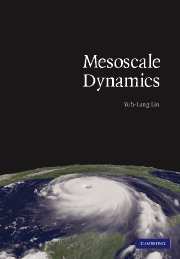Book contents
- Frontmatter
- Contents
- Preface
- 1 Overview
- 2 Governing equations for mesoscale motions
- 3 Basic wave dynamics
- 4 Mesoscale wave generation and maintenance
- 5 Orographically forced flows
- 6 Thermally forced flows
- 7 Mesoscale instabilities
- 8 Isolated convective storms
- 9 Mesoscale convective systems
- 10 Dynamics of fronts and jet streaks
- 11 Dynamics of orographic precipitation
- 12 Basic numerical methods
- 13 Numerical modeling of geophysical fluid systems
- 14 Parameterizations of physical processes
- Appendices
- Index
- References
8 - Isolated convective storms
Published online by Cambridge University Press: 15 December 2009
- Frontmatter
- Contents
- Preface
- 1 Overview
- 2 Governing equations for mesoscale motions
- 3 Basic wave dynamics
- 4 Mesoscale wave generation and maintenance
- 5 Orographically forced flows
- 6 Thermally forced flows
- 7 Mesoscale instabilities
- 8 Isolated convective storms
- 9 Mesoscale convective systems
- 10 Dynamics of fronts and jet streaks
- 11 Dynamics of orographic precipitation
- 12 Basic numerical methods
- 13 Numerical modeling of geophysical fluid systems
- 14 Parameterizations of physical processes
- Appendices
- Index
- References
Summary
Isolated convective storms are generally considered to be cumulonimbus clouds that produce thunder and lightning, heavy rainfall, wind gusts, and occasionally large hail and tornadoes. Understanding the dynamics of isolated convective storms is important because these storms form the building blocks of much more complicated mesoscale convective systems, such as squall lines and mesoscale convective complexes. Aside from their hazards to society, cumulonimbus clouds also play an important role in providing needed rainfall to many regions of the Earth, participating in the general circulation by transporting moisture and sensible and latent heat to the upper troposphere and lower stratosphere, and composing a significant part in the radiative budgets of the atmosphere.
Various methods have been proposed to classify different storm types according to their internal structure, rainfall intensity, potential severity, longevity, and propagation properties. In this text, we adopt standard nomenclature and categorize them as single-cell, multicell and supercell storms. The ordinary, single-cell storm consists of only one convective cell, which is short-lived and often associated with weak vertical shear. When a cluster of single cells at various stages exists simultaneously within a storm, it is called a multicell storm. Multicell storms normally exist in an environment with moderate shear, and have longer lifetimes than single-cell storms since new cells continue to develop along the gust front as the older cells are dissipating.
- Type
- Chapter
- Information
- Mesoscale Dynamics , pp. 272 - 321Publisher: Cambridge University PressPrint publication year: 2007



